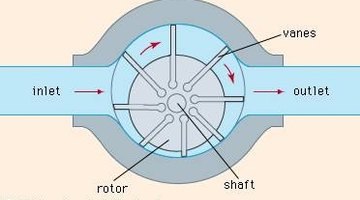How Do Hydraulic Vane Pumps Work?
A hydraulic vane pump is a device used to pump hydraulic fluid from a reservoir into a hydraulic motor or motors. The vane pump is driven by an outside engine such as a diesel engine, which rotates it at a continuous speed. The vane pump is a positive displacement pump. It pumps the same amount of fluid through with each rotation regardless of how much pressure there is in the system.

Vane Pump Basics
Vane Pump Structure

A vane pump has a circular rotor sealed inside of a round casing. The rotor may be in the center of the pump, but it is usually up against the wall between the inlet and an outlet valve. It has one or more vanes which rotate around in a circle, transporting fluid from the input valve to the output valve. As the vanes rotate, they are continuously in contact with the walls of the casing.
How Vane Pumps Work
When a vane rotates past the inlet valve, it creates a vacuum. Fluid is pulled in to fill the vacuum; this fluid travels along with the vane as it turns toward the outlet valve. As the vane approaches the outlet valve, it also approaches the spot where the vane connects with the casing. The fluid is forced into a smaller and smaller area, increasing its pressure. This pressurized fluid has nowhere to flow but out through the outlet valve. Even if the system is already pressurized, a vane pump can create enough force to keep driving fluid through.
Writer Bio
Isaiah David is a freelance writer and musician living in Portland, Ore. He has over five years experience as a professional writer and has been published on various online outlets. He holds a degree in creative writing from the University of Michigan.
More Articles



